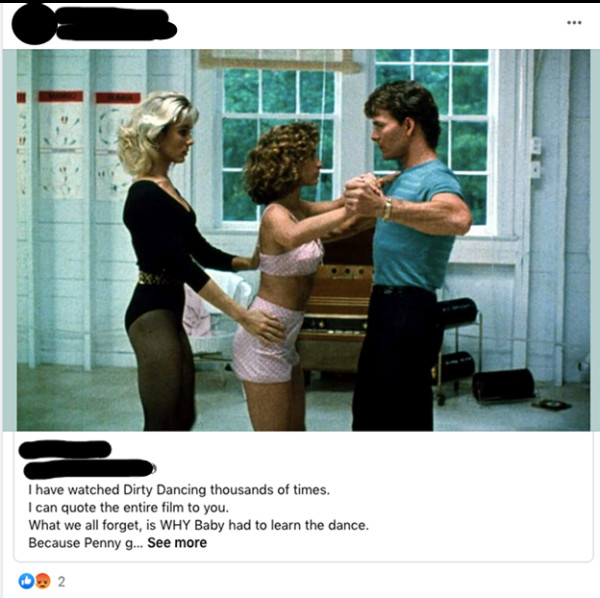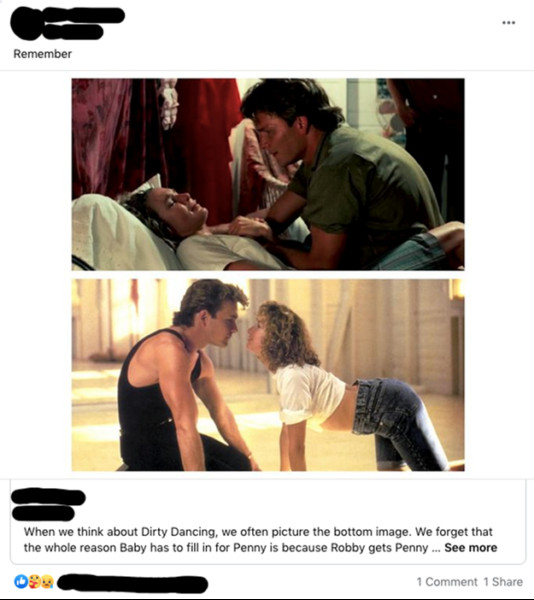The moment news alerts flashed across screens about the overturning of Roe v. Wade, a sense of grim familiarity settled in. This blend of virtual spaces, entertainment, and devastating political events has become a hallmark of our times. Adding to this disorienting feeling was the immediate inundation of social media feeds, particularly Facebook, with images from the 1987 film “Dirty Dancing,” featuring Jennifer Grey and Patrick Swayze.
Instead of finding information about planned protests or actionable responses to the Supreme Court’s decision, my timeline was filled with movie stills from a beloved dance film set in a 1960s Catskills resort. These “Dirty Dancing” memes, a form of Dancing Meme in the broader online landscape, quickly became a dominant visual reaction in the hours and days following the Roe reversal.
 A digitally enhanced photo features a Facebook post that includes a still from the movie "Dirty Dancing." In the image, two women and a man are depicted practicing dance steps, set against a blurred background of other individuals. The post's text reads: 'I have watched Dirty Dancing thousands of times. I can quote the entire film to you. What we all forget, is WHY Baby had to learn the dance. Because Penny g… See more'"
A digitally enhanced photo features a Facebook post that includes a still from the movie "Dirty Dancing." In the image, two women and a man are depicted practicing dance steps, set against a blurred background of other individuals. The post's text reads: 'I have watched Dirty Dancing thousands of times. I can quote the entire film to you. What we all forget, is WHY Baby had to learn the dance. Because Penny g… See more'"
Two main versions of this slacktivist meme circulated widely. One highlighted a scene of Baby learning dance steps, captioned with text emphasizing the forgotten reason behind Baby’s dance lessons: Penny’s need for an abortion.
 A composite image shows two screenshots from Facebook posts, both featuring stills from the movie "Dirty Dancing." The top image depicts a man seated beside a woman who is visibly hunched over in pain on a bed. The bottom image shows the same man dancing intimately with a different woman. Text accompanying the top image in the Facebook post reads: 'Remember When we think about Dirty Dancing, we often picture the bottom image. We forget that the whole reason Baby has to fill in for Penny is because Robby gets Penny … See more'"
A composite image shows two screenshots from Facebook posts, both featuring stills from the movie "Dirty Dancing." The top image depicts a man seated beside a woman who is visibly hunched over in pain on a bed. The bottom image shows the same man dancing intimately with a different woman. Text accompanying the top image in the Facebook post reads: 'Remember When we think about Dirty Dancing, we often picture the bottom image. We forget that the whole reason Baby has to fill in for Penny is because Robby gets Penny … See more'"
The second meme juxtaposed the iconic romantic image of Johnny and Baby dancing with a less frequently remembered scene of Penny in distress due to a botched illegal abortion. This meme urged viewers to “remember” the context of Penny’s plight, suggesting that “Dirty Dancing” was fundamentally about the dangers of restricted abortion access.
As someone who grew up with “Dirty Dancing,” I’m part of the “we” these memes address. I first watched the film at a friend’s 17th birthday party, the same age as Baby in the movie. Like many others, I briefly sported a perm inspired by Jennifer Grey and embraced jean shorts. While “thousands of times” might be an exaggeration, I can certainly quote the famous line, “Nobody puts Baby in a corner,” and manage a karaoke rendition of “(I’ve Had) The Time of My Life.” However, when I think of “Dirty Dancing,” the image of Baby kneeling before Johnny doesn’t immediately come to mind, nor do I primarily associate the film with the perils of back-alley abortions. That’s because, at its core, that isn’t really what the film is about.
“Dirty Dancing,” like many mid-budget American movies from the 1980s, is more accurately a story about class divisions, the sexual objectification of young women, and, undeniably, successful soundtrack sales. The abortion plot point, emphasized in these dancing memes, is precisely that – a plot point. The film dedicates far more screen time to subtly showcasing Jennifer Grey’s sensuality than to the tragic narrative of Penny, the working-class dance instructor who becomes pregnant and is abandoned by a privileged waiter at Kellerman’s resort.
While Penny’s unwanted pregnancy and subsequent illegal abortion do drive the plot forward, they are ultimately overshadowed by the very imagery these memes utilize – the romantic and sensual scenes between Johnny and Baby. If “Dirty Dancing” intends to deliver a message about the dangers of illegal abortions, it does so in a peculiar way. The brief, somewhat veiled depiction of Penny’s suffering after the abortion—sweaty, moaning, with subtly bloodied sheets—is immediately followed by a less subtle, slow-motion sex scene between Baby and Johnny, also replete with sweat and moans. Notably absent from this scene, and subsequent intimate encounters, is any suggestion of contraception use by either Baby or Johnny.
The central appeal of “Dirty Dancing” lies in watching Baby and Johnny’s dance and burgeoning romance, set against a backdrop of popular 1950s music. Perhaps because the film was produced during a time when federal abortion rights were protected, the filmmakers felt a degree of freedom to touch upon the issue of illegal abortion within a mainstream, nostalgic narrative. This is arguably commendable. However, as evidenced by the dancing memes, this was not the primary takeaway for many viewers.
Re-watching the film recently, I considered what messages I, as part of the “we” audience, absorbed. Several themes emerged. Much of the film portrays Johnny teaching Baby to dance through a method that involves yelling and physical manipulation. These scenes, in retrospect, reinforce the idea that women should defer to male leadership and seek direction by gazing into men’s eyes rather than thinking for themselves. This aligns with other problematic messages prevalent in 1980s media.
The iconic lift, where Johnny raises Baby above his head, is the film’s most enduring image. Baby’s initial failure to execute the lift during the Mambo at The Sheldrake and her eventual success in the final performance becomes the cinematic resolution of their relationship. This arguably suggests that a woman’s worth is tied to her willingness to be lifted and supported by a man, a message that feels outdated and unsettling today.
Furthermore, considering Baby’s actions—obtaining the money for Penny’s abortion from her father, learning Penny’s part in the Mambo, bringing her doctor father to Penny’s aid after the botched procedure, and then engaging in sexual activity with Johnny—a re-examination of “Dirty Dancing” reveals a troubling subtext. It suggests that sex carries different consequences based on class: it’s dangerous for working-class women like Penny, but privileged white girls like Baby can engage in it with relative impunity. While this interpretation is apparent now, it’s unlikely to have been the film’s intended message.
We currently exist in a media landscape where infotainment often serves as our quickest and most accessible outlet for responding to political crises. However, it’s crucial to question the efficacy of this approach. The more I examine these “Dirty Dancing” dancing memes, with their clickbait invitation to “… See more,” the more I recognize a troubling parallel to the film’s treatment of Penny. The memes, much like the film’s narrative, seem to ultimately subsume Penny’s story.
While the truncated text in these memes is due to Facebook’s algorithm rather than a deliberate erasure of Penny’s experience, the effect is similar. And while these memes likely appeared on my feed because my online network consists largely of Gen X women who support reproductive rights and sought generational solidarity in response to the loss of bodily autonomy, their impact remains questionable.
There’s no doubt that many Gen X women, including those who created and shared these memes, genuinely care about reproductive rights. The memes evoke nostalgia for the 1980s, mirroring the film’s own nostalgia for the 1950s and 60s. I understand the appeal of 1980s nostalgia right now; the year “Dirty Dancing” premiered was the same year my best friend and I took a bus to Planned Parenthood to obtain birth control prescriptions, confident that if we became pregnant, we would have the choice not to carry the pregnancy to term.
The core issue isn’t that “we” have forgotten the reason Baby had to learn the dance. The real problem is that today’s teenagers lack the same rights and freedoms that we possessed when “Dirty Dancing” was first released. Dancing memes, while visually engaging and emotionally resonant for some, risk simplifying complex political realities and substituting online gestures for meaningful action in the fight for reproductive rights.
Leah Shafer is Chair of the Media and Society Program at Hobart and William Smith Colleges. She is Associate Producer of the Finger Lakes Environmental Film Festival.

